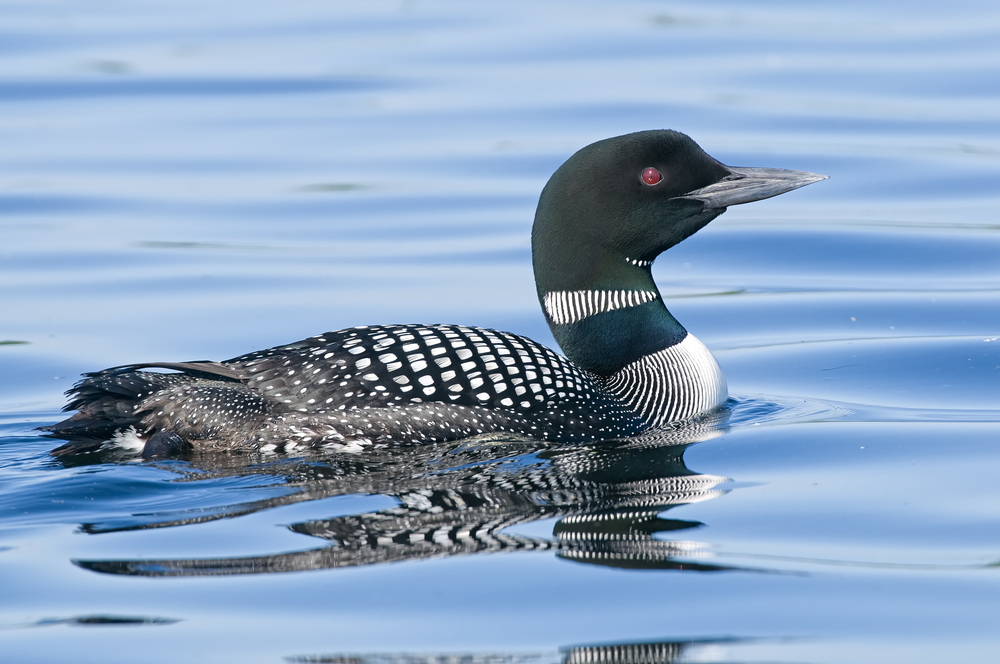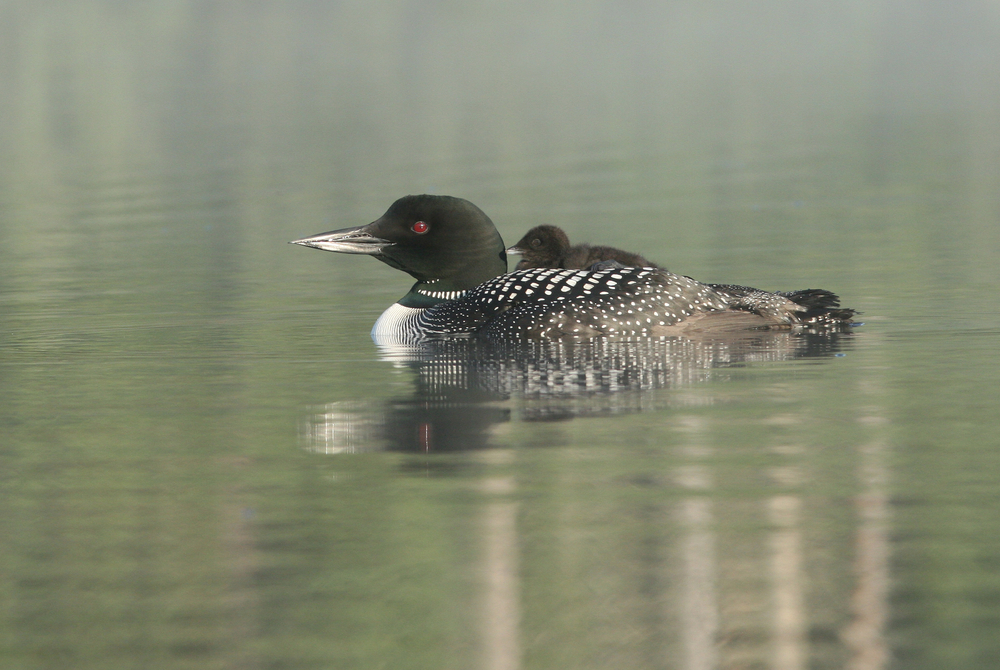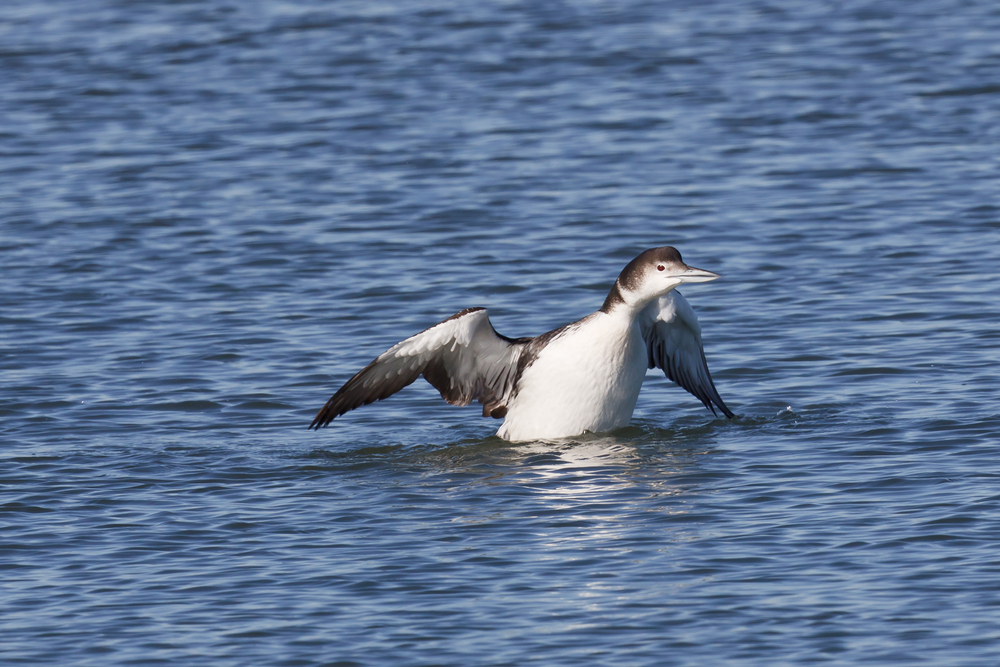Facts About the Common Loon

Loons are swimming and diving birds. They have very distinctive bodies: long and low-slung with spear-like beaks and blood-red eyes. In addition to their unusual bodies, they have an eerie, haunting call that some consider a characteristic sound of early summer.
Common loons are the most widespread and well-known species of loon in North America. There are four other species: red-throated loon, Pacific loon, Arctic loon and yellow-billed loon. A scruffy common loon is featured as a character in the animated movie "Finding Dory."
Description
Loons walk clumsily on land; that's how they got their name, according to National Geographic. They are unable to walk easily on land because their legs are located far to the rear of their bodies, according to the Audubon Society. That position also makes them powerful swimmers, however.
Common loons are larger than the other loon species, according to the Animal Diversity Web (ADW). Adults are 28 to 35 inches (70 to 90 centimeters) long with a wingspan of 60 inches (152 cm). Their weight ranges from 3.5 to 17.6 lbs. (1.6 to 8 kilograms).
In the summer, adults have a black-and-white checkered back. Their heads are an iridescent black and they have a prominent white "necklace," according to the Loon Preservation Committee. In the winter, a loon's plumage turns gray above with a white breast, belly and wing linings.
Habitat
Loons are migratory. This means they live in one place and fly to another place to breed. They also stay close to large bodies of water, no matter where they are.
The common loon breeds in forested lakes and large ponds found in Greenland, Iceland and northern North America. In the winter, they live along the Pacific and Atlantic coasts of North America, Iceland and Europe, according to National Geographic.
Get the world’s most fascinating discoveries delivered straight to your inbox.
Habits
Common loons are not social birds. You can usually find them by themselves during the day. At night, though, they sometimes stick together in groups called flocks while they sleep. When they migrate, they typically fly alone, though some like to group up during the journey.
In one way, loons are like airplanes: they need a runway to take off. Loons will flap their wings and run about 30 yards across the surface of the water in order to gain enough speed for liftoff, according to the Cornell Lab of Ornithology.
In another way, loons are like submarines: they can dive below the water. Common loons spend a lot of time sticking their heads below water to look for fish, and then suddenly diving after their prey. Loons have solid bones, unlike other birds. This makes them less buoyant and better at diving. They quickly expel air from their lungs and flatten their feathers to remove air from within their plumage so they can dive deep and swim quickly.
Cry of the loon
According to the Loon Preservation Committee, researchers have identified four distinct calls used by loons: tremolo, wail, yodel and hoot. These vocalizations are used in courtship and territorial disputes, communication between pairs and offspring, and among flock members, and to signal alarm, according to the ADW.
Diet
Common loons are carnivores, which means they eat meat. Typically, common loons will make meals of fish and crayfish, shrimp and leeches they find around their home. As they dive to catch their prey, most of what they catch is immediately eaten before they surface.
Offspring
Loons are monogamous, according to the Cornell Lab. Pairs typically bond for about five years. When common loons get to their breeding area and mate, the females lay their eggs beside bodies of water or in shallow water. The nest is usually built by both the male and female on the ground. The female will then sit on the eggs for 27 to 30 days before they hatch.
Hatchlings are covered in dark downy feathers and have white bellies, according to the Loon Preservation Committee. Chicks sometime ride on their parent’s backs, usually for the first seven to 10 days. They can, however, swim and dive after just two to three days, and by 12 weeks they are able to fly on their own. Chicks become independent when they learn to fly, leaving their parents. At 2 to 3 years old the young will be mature enough to mate.
No one knows exactly how long common loons live in the wild. Some, such as the Animal Diversity Web, report that 9 years is as long as they live while others, like National Geographic, report 30 years.
Classification/taxonomy
Here is the classification of loons, according to Integrated Taxonomic Information System:
Kingdom: Animalia Subkingdom: Bilateria Infrakingdom: Deuterostomia Phylum: Chordata Subphylum: Vertebrata Infraphylum: Gnathostomata Superclass: Tetrapoda Class: Aves Order: Gaviiformes Family: Gaviidae Genus: Gavia Species:
- Gavia immer (common loon)
- Gavia stellata (red-throated loon)
- Gavia pacifica (Pacific Loon)
- Gavia arctica (Arctic loon)
- Gavia adamsii (yellow-billed loon)
Conservation status
The International Union for Conservation of Nature’s Red List classifies the common loon as least concern, which means it isn’t endangered and is not close to being endangered.
This may change, though. By 2080, the common loon may lose 56 percent of its current summer range and 75 percent of its current winter range due to global warming, according to a climate model created by the Audubon Society. Loss of range can mean a decrease in population, which can eventually lead to extinction.
The yellow-billed loon is on the Red List as near threatened. While accurate data is lacking, it is suspected that populations are declining rapidly.
Other facts
The Inuit tribe legally hunts over 4,500 common loons a year for food, according to National Geographic. They are also a food source for the Cree tribe of Canada.
The U.S. Geological Survey found that a loon traveled 670 miles (1,078 kilometers) within a 24-hour period.
Additional Resources

 Live Science Plus
Live Science Plus







